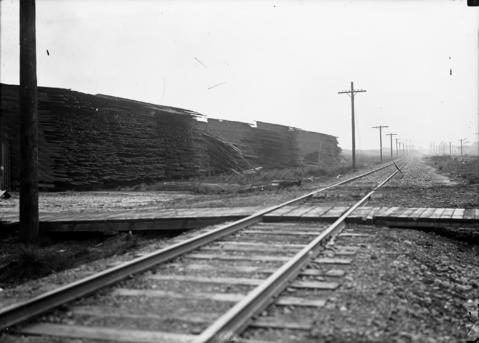Identity elements
Reference code
Name and location of repository
Level of description
Item
Title
BOLAND SPEEDWAY-045
Date(s)
- 1914 (Creation)
Extent
Name of creator
Content and structure elements
Scope and content
ca. 1914. Lumber to be used to build Tacoma's wooden track in stacks at the Speedway. Prior to 1914, the two-mile oval Tacoma Speedway was a dirt track which often provided a jolting, tough ride. When it rained and the track became too soggy for use, races were cancelled. In 1914 a split board track consisting of Washington fir 2 x 4's replaced the dirt. These planks were laid on edge, 5/8th of an inch apart, and nailed down. 2,000,000 feet of lumber, board measure, were used and 72 miles of wire were necessary to make the nails. The spaces between the planks were filled with 2500 cubic yards of gravel and sand. About 500 barrels of Richmond road oil were applied hot to the surface and about 400 cubic yards of sand was spread on top of the oil. This method would hopefully prevent holes from appearing in the track thereby lessening the chance of accidents. Several auto racers, including Earl Cooper, Jim Parsons, Hughie Hughes, Billy Carlson, Wilbur De Alene and G.E. Ruckstell, had previously advised that the Speedway should be paved with creosote wood blocks instead to make it the fastest and safest auto racetrack in the world. The ride would be smoother and it would be easier on the tires and less strain on the driver. (TNT 7-5-14, 5-B-article on creosote blocks) (information on track construction: Standard Oil Bulletin, Vol. 3, ca. 1915)
Tacoma Speedway (Lakewood); Racetracks--Lakewood--1910-1920; Lumber;

